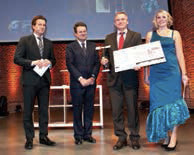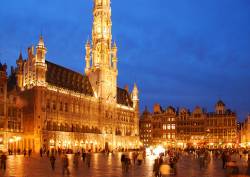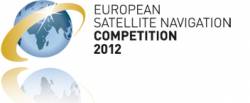 The 2012 Galileo Master receiving his prize: from left, Thorsten Rudolph, managing director of Anwendungszentrum GmbH Oberpfaffenhofen (AZO); Carlo des Dorides, executive director, the European GNSS Agency (GSA); winner Dirk Elias, Fraunhofer Portugal; Ulrike Daniels, AZO director of business development.
The 2012 Galileo Master receiving his prize: from left, Thorsten Rudolph, managing director of Anwendungszentrum GmbH Oberpfaffenhofen (AZO); Carlo des Dorides, executive director, the European GNSS Agency (GSA); winner Dirk Elias, Fraunhofer Portugal; Ulrike Daniels, AZO director of business development.Finding your way indoors will be even easier with a new smartphone app from two Portuguese research institutes that augments GNSS with positioning using ultra-low magnetic field communication (ULF-MC).
Fraunhofer Portugal and the University of Porto’s Faculty of Engineering received the €20,000 Galileo Master’s prize for their innovation in this year’s European Satellite Navigation Competition (ESNC 2012) awards. The ULF-MC application was the overall winner from among 406 completed entries (the most ever) submitted from more than 40 countries.
Finding your way indoors will be even easier with a new smartphone app from two Portuguese research institutes that augments GNSS with positioning using ultra-low magnetic field communication (ULF-MC).
Fraunhofer Portugal and the University of Porto’s Faculty of Engineering received the €20,000 Galileo Master’s prize for their innovation in this year’s European Satellite Navigation Competition (ESNC 2012) awards. The ULF-MC application was the overall winner from among 406 completed entries (the most ever) submitted from more than 40 countries.
Dirk Elias, president of the Fraunhofer Portugal Executive Board and director of the institute’s Research Center for Assistive Information and Communication Solutions, accepted the prize during an October 25 ceremony at Munich’s Der Residenz.
The ULF-MC technology takes advantage of three-axis hall sensors (electronic compasses) already on board most smartphones to provide the relative positioning. The sensor can be used to receive artificial magnetic fields that are modulated with ultra low frequencies (below 50 hertz), requiring only the addition of software to the mobile device. Buildings can be easily retrofitted with the low-cost ULF-MC infrastructure, Elias says. The relative locations can be converted to absolute positions by using the most recent GNSS fix.
The app has been tested and is under development, with patents pending in Europe and the United States. The next step, according to Elias, is to license the technology to interested companies in order for them to start building products. Although designed for indoor use by humans, ULF-MC can also be used to extend the reach of GNSS to tunnels for car navigation or to increase outdoor accuracy related to points of interest.
A panel of expert judges selected the Galileo Master from among the 24 winners in ESNC competitions held by regional partners. The ESNC is sponsored by the European GNSS Agency (GSA), the European Space Agency (ESA), the European Commission, the Free State of Bavaria, and the German Space Center (DLR}. The competition is organized by Anwendungszentrum GmbH Oberpfaffenhofen (AZO), a Bavarian economic development and business incubation center.
This is the ninth year for the competition, which has grown from a Europe-only affair to an international forum for GNSS innovation. The application fields drawing the most responses this year were mobile location-based services (35 percent of all submissions) and “smart moving” (29 percent).
Winners of Special Prizes
Consumer-oriented navigation aids also featured among winning entries in the seven ESNC special prize categories.
GSA EGNOS Application. An idea to help visually impaired people navigate using sound cues and augmented satellite navigation signals captured the GSA Special Topic Prize for the most promising EGNOS application idea, exploiting the European Geostationary Navigation Overlay Service.
The GSA prizewinner, 3SOUND, integrates acoustic binaural technologies (i.e., 3D sounds) and GNSS to guide people via open earphones to aid the blind, others with sight impairments, and people working in low-visibility environments (emergency and rescue services).
The concept is the brainchild of Rafael Olmedo, who conceived the idea while working at the Spanish National Institute of Aerospace Technology (INTA) in Madrid. 3SOUND is currently being developed and validated under the ARGUS project (Assisting personal Guidance system for people with visual impairment), funded by the European Union’s 7th Framework Program.
The 3SOUND concept offers a low-cost solution based on the use of the EGNOS SDK (software development toolkit) developed by the GSA to allow the full capabilities of EGNOS augmented navigation capabilities to be realized on normal smartphone technology.
According to the GSA, Olmedo is now working as a project manager for OK-Systems, a Spanish firm specializing in space programs and engineering, but he has also founded a start-up company (GEKO NAVSAT) that will further develop and commercially exploit the 3SOUND concept with the ARGUS consortium.
Winners of the GSA prize receive six months of support at the European innovation incubator of their choice with the possibility of extending the assistance to a year. The prize has a maximum value of € 40,000 (US$52,000).
ESA Innovation Prize. Jonathan Durant, of France, took home the €10,000 ESA Innovation Prize, for “Project Citizen First Aid,” another smartphone app that enables people in distress to call for assistance to others in nearby locations.
University Challenge. The University Challenge special prize, sponsored by the GNSS Education Network for Industry and Universities (GENIUS), went to Luis Gomes and Filipe Sousa, of Portugal, for “Access ON.” The crowd-sourced app allows individuals encountering an accessibility problem to automatically geoposition, photograph, describe, and identify the inaccessibility and upload the information to an associated website. Access ON will have partnerships with organizations capable of correcting the problems submitted.
ITRI Prototyping Award. The prototyping prize, sponsored by Taiwan’s Industrial Technology Research Institute, went to a team from HAITEC Automobile Information Technical Center, an R&D company that specializes in the integration of mobile IT into the automobile industry value chain.
Their innovation, D.S.R.C. (Driving with Safety, Responsiveness and Courtesy!) integrates DSRC communications, a novel software-based dead reckoning algorithm capable of reducing positioning error to two meters, and an in-vehicle CAN bus-monitoring scheme to create “a new communication model for everyday drivers.” Drivers can send emergency warnings and receive “thank-you” messages in return.
GNSS Living Lab Prize. “Vamos,” now available as a downloadable iTunes app, won the GNSS Living Lab prototyping prize sponsored by Galileo Advanced INnovation Services (GAINS). The mobile application combines Facebook and Instagram functionality in order to “pry friends away from their screens and get them together in real life.” The innovation combines geo-location-tagged Facebook events, Instagram photos, and information on event attendance to discover where a Vamos user’s friends are going and what the day’s most interesting local happenings are.
HPI Prototyping Prize. Another special prize sponsored by HPI Fleet & Mobility AG went to a team from Fraunhofer Institute for Material Flow and Logistics IML in Prien am Chiemsee, Germany. The entry, “immer MOBIL,” seeks to match transportation needs and GNSS Living Lab: Vamos user interface ITRI Prototyping Prize Winner: D.S.R.C. available transportation services in rural areas by combining specialized telematic, information, and communication technologies. In addition to traditional public transportation services, these new approaches include alternatives such as community transportation, private transportation services, and shared taxis.
DLR Prize. Among the top ESNC prizewinners, a GNSS Based Attitude Determination (GBAD) technique submitted by Boris Vassilev, an associate professor at the Technical University of Sofia, and Boriana Vassileva, with the Institute for Information and Communication Technologies, Bulgarian Academy of Sciences, received the DLR prize. The GBAD technique exploits velocity information measured by one or two GNSS receiver antennas shuttled within the body coordinate system of an aircraft, vehicle, or vessel.




